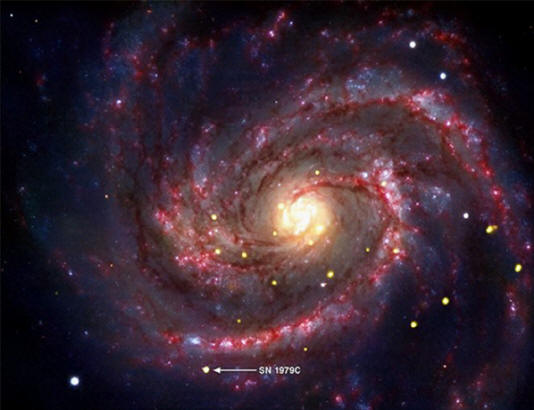Zero
volume and near-infinite density are
incompatible with three-dimensional space.
The Virgo Cluster harbors several galaxies that
are listed in the early Messier catalog. Among
them are
M61,
M90, and
M100. M100 is particularly
interesting to NASA scientists who, in
conjunction with the Chandra X-ray Telescope
team, called a
special press conference on November
15, 2010 in order to announce the discovery of
"the youngest black hole ever detected."
The object thought to be a black hole was
identified by an excessively bright X-ray
emission that has not varied in brightness for
more than 12 years. According to consensus
theories, the steady state of the radiation
indicates that material is being superheated as
it falls into the black hole's steep
gravitational gradient.
SN 1079C, a supernova, is thought to have
"given birth" to the black hole because when
stars more than 5 times as massive as the Sun
"explode," they are thought to leave behind
compacted remains that can fall in on themselves
until they attain near-infinite gravity in a
zero volume. There are several opinions inherent
in NASA's conclusion to which Electric Universe
advocates would object.
First, what is a supernova? As
previous Picture of the Day articles
have argued, stars do not age and die in the way
that conventional understanding proposes. Stars
are not globes of hot gas under pressure, they
are composed of plasma. Plasma is ionized and is
an electrically charged substance. Since it is
ionized, it does not behave like a pressurized
gas, so shock waves and gravitational
instabilities are insufficient when it comes to
explaining the birth and death of stars.
As Electric Universe theory states, a
supernova is an exploding star, but not in the
conventional sense. Rather, it constitutes the
explosion of a double layer in plasma. The power
comes from external electric currents flowing
through vast circuits in space, so the radiation
from stars is due to discharges that vary in
strength. It is those electric arcs that make up
the stellar corona, chromosphere and photosphere
of our Sun, for instance.
Supernovae are the result of a stellar "open
circuit” in the galactic power supply. The
result is the same as sometimes occurs in
high-voltage switching yards, with extensive
arcing.
In an exploding double layer, the energy of
an entire circuit might flow into the explosion,
increasing its expansion far from the surface of
the star. Radiation from the double layer shines
in ultraviolet or X-ray wavelengths, sometimes
emitting bursts of gamma rays. It was those
effects that should have been considered when SN
1979C was first identified.
Second, what is a black hole? Black holes are
theorized to twist space and time so that
velocity calculations yield impossible
solutions. Matter inside a black hole occupies
no volume at all, yet it retains gravitational
acceleration so great that not even light can
escape its attraction—the hole is "black"
because it cannot be detected with optical
telescopes.
Several previous Picture of the Day
discussions about black holes determined that
the language used by astrophysicists is itself
problematic, relying on highly speculative
explanations. Ambiguous lexical labels such as
space/time, multiple universes, singularities,
infinite density, and other ideas that are not
quantifiable have introduced irony into what
should be a realistic investigation.
It is assumed that matter
falling into the intense gravity well
of a black hole is accelerated and subsequently
compressed. Material orbits the black hole at a
faster and faster rate as it gradually spins
closer to a point several times the mass of our
Sun. The X-rays and ultraviolet light emissions
are interpreted by astronomers as gas heating up
from atomic collisions in the rotating disc.
Finally, hot gas, no matter how fast it
moves, is not the principal cause of X-rays.
Laboratory experiments most easily produce them
by accelerating charged particles through an
electric field. No gigantic masses compressed
into tiny volumes are necessary; they are easily
generated with the proper experiments.
There is no experimental evidence that matter
can be compressed to “near-infinite density."
Compression zones (z-pinches) in plasma
filaments form plasmoids that can become stars
and galaxies. Electricity is responsible for the
birth of stars, and when the stellar circuit
catastrophically releases its excess energy it
appears as gamma ray bursts or X-rays or flares
of ultraviolet light.
In the electric star hypothesis, no
concentrated gravity from "singularities" is
necessary. Classical understanding of
electromagnetism reveals that it is more than
able to create the phenomena we see, without
recourse to the supernatural physics of black
holes.
Meanwhile astrophysicists, untrained in the
physics of double layers, treat supernovae
remnants as a problem in fluid dynamics, using
mechanical shockwaves and gravitational pressure
to provide the observed energies. It is an
approach that Hannes Alfvén warned, more than
half a century ago, is doomed to fail.
Stephen Smith
A video documentary that could
change everything you thought you
knew about ancient times and
symbols. In this second episode of
Symbols of an Alien Sky, David
Talbott takes the viewer on an
odyssey across the surface of Mars.
Exploring feature after feature of
the planet, he finds that only
electric arcs could produce the
observed patterns. The high
resolution images reveal massive
channels and gouges, great mounds,
and crater chains, none finding an
explanation in traditional geology,
but all matching the scars from
electric discharge experiments in
the laboratory. (Approximately 85
minutes)





 New
DVD
New
DVD

